Capacitance Based Non Destructive Technique for Post-harvest Sugarcane Quality Estimation
Info: 15319 words (61 pages) Dissertation
Published: 21st Feb 2022
Tagged: Agriculture
ABSTRACT
Post harvest deterioration of sugarcane is one of the major issues that affect the sugar industries during sugar production. To reduce the loss incurred by sugar industries, dielectric based non destructive technique for post harvest quality determination of Sugarcane stalks was developed. The relative permittivity of sugarcane stalks were recorded from four commercial varieties (Co 95020, Co 86010, Co 86032 and Co 06022). A 5V sinusoidal wave of different frequencies ranging between 0 – 1MHz was swept across the Parallel Plate Capacitor with Sugarcane stalk samples as the dielectric medium. The results obtained show a consistent reduction of dielectric constants with respect to the time after harvest. The relationship between dielectric constants and existing quality indices of sugarcane was investigated and it was found that the dielectric constant decreased due to increase in crushing delays. The 1 kHz frequency was seen to be the most suitable frequency in estimating the quality of sugarcane.
Keyword: Sugarcane; Post Harvest; Quality deterioration; Dielectric constant; Moisture content; Brix.
TABLE OF CONTENTS
Click to expand Table of Contents
| CHAPTER NO | TITLE | PAGE NO |
| LIST OF ABBREVIATIONS | v | |
| 1 | INTRODUCTION | 1 |
| 1.1. MOTIVATION | 1 | |
| 1.2. STATEMENT OF THE PROBLEM | 1 | |
| 1.3. RESEARCH OBJECTIVES | 2 | |
| 1.4. OUTLINE OF CHAPTERS | 2 | |
| 2 | BACKGROUND AND LITERATURE STUDY | 4 |
| 2.1. INTRODUCTION | 4 | |
| 2.2. SUGARCANE | 4 | |
| 2.2.1. Crop biology | 4 | |
| 2.2.2 Composition | 5 | |
| 2.3. CULTIVATION OF SUGARCANE | 5 | |
| 2.4. MAJOR PROBLEMS FACED BY SUGARCANE GROWERS | 7 | |
| 3 | SUGARCANE QUALITY ESTIMATION USING DESTRUCTIVE TECHNIQUES | 10 |
| 3.1. °BRIX MEASUREMENT | 10 | |
| 3.2. %POL MEASUREMENT | 11 | |
| 3.3. COMBINED °BRIX %POL MEASUREMENT | 13 | |
| 3.3.1. High performance Liquid Chromatography | 13 | |
| 3.3.2. NIR Spectroscopy | 14 | |
| 3.3.3. Biosensors | 16 | |
| 4 | SUGARCANE QUALITY ESTIMATION USING NON DESTRUCTIVE TECHNIQUES | 20 |
| 4.1. ELECTRONIC REFRACTOMETER | 20 | |
| 4.2. MICROWAVE | 21 | |
| 4.3. PORTABLE SPECTROMETER | 22 | |
| 4.4.1. Coaxial Probe | 23 | |
| 4.4.2. Transmission Lines | 24 | |
| 4.4.3. Free Space | 25 | |
| 4.4.4. Resonant Cavity | 25 | |
| 4.4.5. Parallel Plate Capacitor | 26 | |
| 5 | POST-HARVEST QUALITY ESTIMATION BY CAPACITANCE BASED TECHNIQUE | 29 |
| 5.1. INTRODUCTION | 29 | |
| 5.2. MATERIAL AND METHODS | 31 | |
| 5.2.1. Sugarcane Samples | 31 | |
| 5.2.2. Measurement Setup and dielectric modeling for sugarcane | 32 | |
| 5.2.3. Mathematical Modeling | 33 | |
| 5.2.4. Laboratory Measurement of °Brix and weight loss | 33 | |
| 5.2.5. Statistical analysis | 34 | |
| 5.3. RESULTS AND DISCUSSIONS | 34 | |
| 5.3.1 Variation of relative permittivity over time | 34 | |
| 5.3.2 Variation of Total Soluble Solids (˚Brix) over post harvest days | 36 | |
| 5.3.3 Variation of dielectric permittivity with respect to Total Soluble Solids (˚Brix) | 37 | |
| 5.3.4 Variation of weight loss over time | 40 | |
| 5.3.5 Variation of dielectric permittivity with respect to percentage weight loss | 41 | |
| 5.4. VALIDATING BEST FREQUENCY FOR SUGARCANE QUALITY PREDICTION | 44 | |
| 6 | CONCLUSIONS AND FUTURE SCOPE | 47 |
| REFERENCES | 49 |
LIST OF SYMBOLS
| SYMBOL | DESCRIPTION | PAGE NO |
| °Bx | °Brix | 10 |
| V | Voltage | 11 |
| %Pol | Polarimeter Reading | 13 |
| εr, | Relative Permittivity | 23 |
| µr | Refractive Index | 24 |
| Q | Quality Factor | 26 |
| C | Capacitance | 32 |
| ω | Frequency | 32 |
| Z | Impedance | 32 |
| D | Distance | 33 |
| A | Area | 33 |
| F | Farad | 33 |
LIST OF ABBREVIATIONS
| ABBREVIATION | EXPANSION | PAGE NO |
| CO | Coimbatore | i |
| TMT | Thousand Metric Tons | 1 |
| AUD | Australian Dollar | 10 |
| CCD | Charged Coupled Device | 10 |
| LCD | Liquid Crystal Display | 11 |
| HPLC | High Performance Liquid Chromatography | 14 |
| NIR | Near Infrared | 15 |
| DNA | Deoxyribo Nucleic Acid | 18 |
| LED | Light Emitting Diode | 20 |
| VNIR | Very Near Infrared | 22 |
| USB | Universal Serial Bus | 24 |
| MDO | Mixed Domain Oscilloscope | 31 |
LIST OF FIGURES
Click to expand List of Figures
| FIGURE NO | TITLE | PAGE NO |
| 2.1 | Sugarcane internode | 5 |
| 3.1 | Refractometer | 12 |
| 3.2 | Polarimeter principle | 14 |
| 3.3 | High-Pressure Liquid Chromatography | 15 |
| 3.4 | NIR Spectroscopy | 17 |
| 3.5 | Principle of Biosensors | 19 |
| 4.2 | Microwave Heating | 23 |
| 4.4.1 | Coaxial Probe | 25 |
| 4.4.2 | Transmission Lines | 26 |
| 4.4.3 | Free Space method | 27 |
| 4.4.4 | Resonant Cavity | 28 |
| 4.4.5 | Parallel Plate Capacitor | 29 |
| 5.2.1 | Measurement Set-Up for Post-harvest Quality Estimation | 34 |
| 5.3.1.a | Time (in Days) vs. Relative permittivity for CO 95020 | 36 |
| 5.3.1.b | Time (in Days) vs. Relative permittivity for CO 86032 | 36 |
| 5.3.1.c | Time (in Days) vs. Relative permittivity for CO 06022 | 37 |
| 5.3.1.d | Time (in Days) vs. Relative permittivity for CO 86010 | 37 |
| 5.3.2 | Fig Variation of Total Soluble Solids (˚Brix) over post harvest days | 38 |
| 5.3.3.a | Variation of TSS with Relative permittivity values for CO 95020 | 39 |
| 5.3.3.b | Variation of TSS with Relative permittivity values for CO 86032 | 39 |
| 5.3.3.c | Variation of TSS with Relative permittivity values for CO 86010 | 40 |
| 5.3.3.d | Variation of TSS with Relative permittivity values for CO 06022 | 40 |
| 5.3.4 | Variation of weight loss over time for all varieties | 42 |
| 5.3.5.a | Variation of dielectric permittivity with respect to percentage weight loss for CO 95020 | 43 |
| 5.3.5.b | Variation of dielectric permittivity with respect to percentage weight loss for CO 86032 | 43 |
| 5.3.5.c | Variation of dielectric permittivity with respect to percentage weight loss for CO 86010 | 44 |
| 5.3.5.d | Variation of dielectric permittivity with respect to percentage weight loss for CO 06022 | 44 |
LIST OF TABLES
Click to expand List of Tables
| TABLE NO | TITLE | PAGE NO |
| 2.1 | Constituents of sugarcane | 5 |
| 2.2 | Top ten sugarcane producers of the year 2015 | 6 |
| 2.3 | Utilization of sugarcane for different purposes in India during 2005-2006 to 2014-15 | 6 |
| 5.3.3 | Polynomial regression done for all varieties for relative permittivity vs TSS. | 41 |
| 5.3.5 | R2 values for Relative permittivity values vs % Weight Loss | 45 |
| 5.3.6 | Frequencies for which the R2 values in both tables 1 and 2 greater than 0.95 are tabulated in table 5.3.5. | 46 |
1. INTRODUCTION
1.1. Motivation
India is the second largest sugarcane producing country in the world with 341200 TMT tons. One of the present technical limitations faced in sugar industries is the lack of a low cost, rapid, nondestructive and efficient technique to determine post-harvest quality of sugarcane. At present, the techniques employed by industries to determine sugarcane quality are destructive and time consuming. This need of a nondestructive technique shaped our desire to research and designs a cost effective and efficient instrument for determining the post-harvest quality of sugarcane.
1.2. Statement of the Problem
Sugar losses after harvest of sugarcane due to delayed transport and unfavorable environmental conditions are one of the most serious problems faced in the sugar extraction process. Studies have indicated that nearly 20-30% of total sucrose (recoverable sugar) synthesized by sugarcane plants is lost during various stages of raw material handling and sugar mill processing. The post-harvest sugar loss is one of the most alarming problems of sugar industry and has attracted widespread attention in the recent years. Still, significant harm is not caused if the cane is crushed in 1 day after harvesting. In between the harvesting and milling, the time lag is generally one to three days during which the extraction of maximum sugar is feasible.
One of the major challenges faced by sugar industry is to provide harvested cane to the mil yard within shortest possible time to minimize the loss of sucrose content in the juice and avoid the deterioration with microbes.
All the above problems affect sugar industries by reducing their expected revenues. This loss in revenue can be avoided if industries have efficient and quick measurements of sugarcane quality measurements. Industries can spot-check their raw material and determine the quality. The quality determined will reflect the amount of recoverable sugar that is present in the raw material.
1.3. Research objectives
The main objective of this study was to analyze
- the relationship between dielectric change in sugarcane with respect to post harvest days
- the other quality parameters like Brix and weight loss changes with respect to days and changes with respect to dielectric values
1.4. Outline of chapters
This project report has been organized into six chapters.
First and Second chapter gives an introduction about Sugarcane, the biology of sugarcane, cultivation and also discusses the problems faced by sugar industries.
Chapter 3 discusses commonly used destructive methods and techniques and Chapter 4 explains various non destructive technique used in quality estimation of sugarcane. The fourth chapter also gives advantages and disadvantages of various methods based on our research objective.
A capacitance based Non destructive technique was designed to estimate the post harvest quality of sugarcane in Chapter 5. The chapter explains the literature survey, sample preparation, measurement setup, results and discussion.
The final chapter contains conclusion and future scope of this research.
2. BACKGROUND AND LITERATURE STUDY
2.1. Introduction
Sugarcane is the main source of white sugar and jaggery. Sugarcane is also used as raw material for manufacturing alcohol, bagasse and biodiesel. Sometimes sugarcane is also used as a fodder for cattle. India is the second largest producer of sugarcane production after Brazil in the world. In addition to yield, sugar is an important sub-sector in the market of many developing countries, which provides extensive employment opportunities and contributes radically to their balance of payments position [1].
2.2. Sugarcane
2.2.1. Crop biology
Sugarcane is a perennial grass of the family Poaceae of the genus Saccharum and its botanical name is Saccharum officinarum. Sugarcane stalks raise to maturity over a period of nine to eleven months. Sugarcane stalk usually grow to about 2.5 m in height with an average radius of 15 mm. Sugarcane is grown from a section of the sugarcane stalk containing a bud. The sugarcane plant make a bud at the leaf and it grow on the band adjoining the stalk[2].
Sugarcane is a crop with its stalk comprises a series of internodes which are separated by joints or nodes. The internodal skin is made up of a hard outer rind which provides strength and protection for the softer inner tissue or pith. The rind which represents 15% of the cross sectional area of the stalk consists of layers of small, highly lignified, and thick-walled cells [3]. The node is an encircling ring from which the leaf sheath grows (Fig 2.1). As sugarcane grows, the leaves of the older nodes die and detach from the stalk and the node is represented by the remaining leaf scar. Above the leaf scar is the root band and growth ring. Within the root band are rows of root primordial and a single bud occurring on opposite sides of the stalk for alternate nodes. The stalk surface is covered with a moisture resistant layer of wax which is thickest just below the node where it forms a wax band. Typically, two types of cracks, ‘corky’ and ‘growth’ cracks may occur within an internode [4].
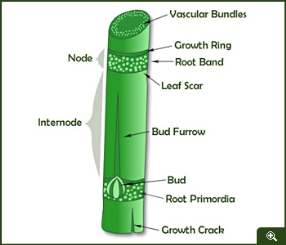
Fig 2.1 Sugarcane internode[5]
2.2.2 Composition
Physical and chemical compositions of sugarcane constitutes of water, sucrose, reducing sugars (glucose, fructose and maltose), organic matters, inorganic compounds, nitrogenous bodies, ash and fiber at various percentages as shown in Table 2.1.
Table 2.1 Constituents of sugarcane
| Constituents | Percentages (%) |
| Water | 69-75 |
| Sucrose | 8-16.4 |
| Reducing sugars | 0.5-2 |
| Organic matter other than sugar | 0.5-1 |
| Inorganic compound | 0.2-0.6 |
| Nitrogenous bodies | 0.5-1 |
| Ash | 0.3-0.8 |
| Fibre | 10-16.5 |
2.3. Cultivation of Sugarcane
India is the largest consumer and second largest producer of Sugar in the world, contributing over 15 percent of the world’s Sugar production through over 500 Sugar factories situated in different parts of the country (Table 2.2). The sugarcane cultivation and sugar industry in India plays a vital role towards socio-economic development in the rural areas by mobilizing rural resources and generating higher income and employment opportunities. About 7.5 percent of the rural population, covering about 45 million sugarcane farmers, their dependents and a large number of agricultural labors are involved in sugarcane cultivation, harvesting and ancillary activities as shown in Table 2.3 [6].
Table 2.2 Top ten sugarcane producers of the year 2015
| Country | Production
(Thousand Metric Tons) |
| Brazil | 739,267 |
| India | 341,200 |
| China | 125,536 |
| Thailand | 100,096 |
| Pakistan | 63,750 |
| Mexico | 61,182 |
| Colombia | 34,876 |
| Indonesia | 33,700 |
| Philippines | 31,874 |
| United States | 27,906 |
| World | 1,877,105 |
Table 2.3: Utilization of sugarcane for different purposes in India during 2005-2006 to 2014-15
| Year | Production of white sugar | Seed
feed and chewing etc |
Sugar and Jaggery | Total production of sugarcane | ||||
| Quantity | Percentage | Quantity | Percentage | Quantity | Percentage | Quantity | Percentage | |
| 2005-06 | 178449 | (59.62) | 34380 | (11.49) | 86495 | (28.90) | 299324 | 295956 |
| 2006-07 | 176648 | (59.69) | 33930 | (11.46) | 85378 | (28.85) | 297208 | 281574 |
| 2007-08 | 180346 | (60.68) | 34724 | (11.68) | 82138 | (27.64) | 237308 | 238147 |
| 2008-09 | 190916 | (67.80) | 33524 | (11.91) | 57134 | (20.29) | 281178 | 355520 |
| 2009-10 | 132511 | (55.84) | 28240 | (11.90) | 76557 | (32.26) | 340494 | 271254 |
| 2010-11 | 124771 | (52.39) | 28210 | (11.85) | 85166 | (35.76) | (100.0) | (100.0) |
| 2011-12 | 188672 | (67.10) | 33460 | (11.90) | 59046 | (21.00) | (100.0) | (100.0) |
| 2012-13 | 277787 | (78.14) | 42307 | (11.90) | 35426 | (9.96) | (100.0) | (100.0) |
| 2013-14 | 249906 | (73.40) | 40526 | (11.90) | 50062 | (14.70) | (100.0) | (100.0) |
| 2014-15 | 144978 | (53.45) | 32550 | (12.00) | 93726 | (34.55) | (100.0) | (100.0) |
Source: Indian Sugar, India Sugar Mills Association, New Delhi, April’2015
In India, there are about nine States where sugarcane is grown on a large extent of area. There are a number of varieties that are grown in India depending on the suitability of the soil and the climatic conditions. In the tropical region, sugarcane gets more or less ideal climatic conditions for its growth. So it contributes about 40 per cent to the total cane production in the country. The sugar production of sugar is spread across the country. In above States, they are classified into three groups according to its production capacity. They are, the high sugar producing States namely Maharashtra and Uttar Pradesh. The second category was the medium sugar producing States namely Gujarat, Andhra Pradesh, Tamil Nadu, Karnataka, and Haryana. The other remaining low sugar producing states were Bihar and Assam.
2.4. Major Problems faced by sugarcane growers
The main issue the cane growers deal with is the high cost of cultivation. This issue is further worsened by the unreasonable price paid for the cane by the sugar industries. High cost of cultivation and the low price for sugarcane is not the only issue of cane cultivators. Marketing and financial issues have also become acute. The problem which the cane growers encounter can be examined under the following three heads:
- Operational Problems
- Marketing Problems
- Financial Problems
The operational problem may be due to lack of fertility of the soil, lack of quality seeds, lack of experienced labor, lack of adequate manures and fertilizers, absence of continuous water supply and absence of improved agricultural practices. Marketing Problem includes delay in harvest, absence of marketing facility, lack of transport facility and loss due to post harvest storage[6]–[8]. A study carried out in the year 2000 has shown loss in Commercial Cane Sugar (CCS) about 3.60 unit in 72 hours during post-harvest storage under open field conditions[7]. Similar studies in 2003 also revealed the loss of CCS during late crushing period. In many sugar factories, time lag between harvesting and milling of sugarcane ranges between 3 to 10 days, which produces huge losses in recoverable sugar causing socio economic problems[9]. The time delay occurs due to collection of whole sugarcane stalks, pre-treatment and transport of canes to the industry. Financial problem includes inadequate finance, absence of quick payment by the purchaser and price fluctuation. The area, output and yield and sugarcane cultivation is subjected to fluctuate in response to policies of the government and also conditions of cultivation. Taking these into consideration, this chapter presents a detailed discussion on the cultivation practices of sugarcane, growth of area, output and yield [10].
3. SUGARCANE QUALITY ESTIMATION USING DESTRUCTIVE TECHNIQUES
°Brix of a solution is the concentration of a solution of pure sucrose in water.Here the density of the solution remains constant at the constant temperature. Its symbol is represented as °Brix which is numerically equal to 1 gram of sucrose in 100 grams of a solution that equals to the strength of the solution as a percentage by mass. A sucrose solution with an clear specific gravity of 1.040 will be 9.99325 °Bx or 9.99359 °P. International Commission for Uniform Methods of Sugar Analysis (ICUMSA) recommends the use of mass fraction, reports the solution strength as 9.99249%.
°Brix can be measured using density or refractive index. The refractive index relates the amount of light that is bent when it passes through two mediums. Various instruments which measure °Brix value is Brix spindle, Brix hydrometer, density meter or Refractometer can be used for measurement. °Brix value is determined by finding the refractive index of the juice sample and it is related to the constituents of the sample. The advantage of using this instrument is it is relatively cheap (AUD$700-5000).Samples of sugarcane were cut into small pieces for each variety. Then it is crushed by using mixer to extract juice from the sugarcane and this juice is tested using a refractometer.
Readings are taken every day in each variety for 4 days and values are recorded in MS Excel sheet. The desktop refractometer may require procedures that are complicated and a very complex preparation before starting to measure. High-precision Computerized Lab Refractometers measure concentrations in °Brix, refractive index and medical parameters with a full-scale precision of 0.1% using CCD scanner. These refractometers are easy to utilize, can be calibrated with distilled water and requires a sample of only 0.4 ml. They instantly display temperature in addition to various measurements and the values are displayed on the LCD. The reliable microprocessor can be calibrated automatically, automatic temperature compensation (ATC), automatic shutoff (after 3 minutes), and visual min/max cautions. Low power utilization gives 5000 readings The water resistant design shields the hardware from wet environment with a 9V battery, distilled water, an exchange pipette, guidelines and a shielding case. Two standard models are available in this arrangement, differs in measuring range.[11].
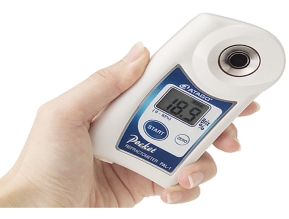
Fig 3.1 Refractometer[12]
°Brix can be measured by the below formulae:
°Brix in cane=°Brix in juice×100-fibre%+3÷100
3.2. %Pol measurement
%Pol is a measure of sucrose and other optically active substances present. Pol is the percentage of sucrose present in the juice. The concentration of pure sucrose solution in water having the similar optical rotation as the sample at identical temperature is called Pol of a solution. An optically active substance can rotate a linearly polarized light. Since sucrose is optically active, its concentration can be calculated. Polarimeters are rational instruments utilized for measuring the rotation of the plane of polarized light as it goes through a sample of a compound which displays optical activity. Numerous chemical compounds can exist in more than one optically active form. Each optically active form, or an isomer, of a compound will have the capacity to turn the plane of polarized light by an amount depending on the characteristics of an isomer. Polarimetry is sensitive, nondestructive method for measuring the optical activity exhibited by these inorganic and organic compounds. The individual eye can’t observe whether light is polarized (light which comprises of waves that vibrate only in one plane) however, the impacts of polarization can be watched utilizing polarizing channels. Polarimetry measures the degree to which a substance communicates with the plane- polarized light and whether it rotates plane- polarized light to right, left, or not towards any side [13].
A substance is optically active if it rotates plane–polarized light to left or to the right. To be optically active, a compound must have a chiral center- a carbon with four distinct different groups attached. Depending on the orientation of these four unique gatherings about the chiral carbon, the compound may turn plane-polarized light to the left or to the right. Compounds that don’t rotate light at all do not have a chiral center. The quantity of degrees and the direction of rotation are measured to give the observed rotation. This estimation must be changed depending on the length of the cell utilized and the solution concentration. Contrasting the altered observed rotation with distributed qualities can help in the detection of an unidentified compound.
For a saccharimeter in sugar analysis, a polarimeter can be used. Among sucrose, glucose, and fructose present in sugarcane juice, only sucrose is used for computation of sugar content in the harvest. By using 200mm tube, 75.2 g of the substance containing sucrose and no other optically active substance dissolved in 100 ml of water, where the rotation in degrees is numerically equal to the concentration of the sucrose expressed in percent by weight. Due to other optically active sugars such as glucose and fructose present, the standardized polarimeter tells that 26g of sucrose present in sugarcane juice dissolved in 100ml water gives a rotation of 100°C.Percentage of sucrose present in sugarcane sample is calculated by multiplying 0.26 with the rotation observed [13]. The earliest polarimeter, which goes back to the 1830s,it is necessary for the client to physically fix one polarizing medium (the analyzer) while seeing through an additional static medium(the detector). The detector was situated at the opposite end of a tube containing the optically active sample, and the client utilized his/her eye to judge the “arrangement” for seeing a thin beam of light. The angle of rotation was then read from a simple fixed to the moving polarizer in degrees. Entirely programmed polarimeters are currently available and essentially require the client to press a button and wait for a automated readout. They yield an exact result within a moment, regardless of the rotation of the sample. . Another component of present day polarimeter is the Faraday modulator. The Faraday modulator makes an AC magnetic field. It oscillates the plane of polarization to augment the accuracy of detection by permitting the point of maximal darkness to be passed through repeatedly and thus be determined with great accuracy.
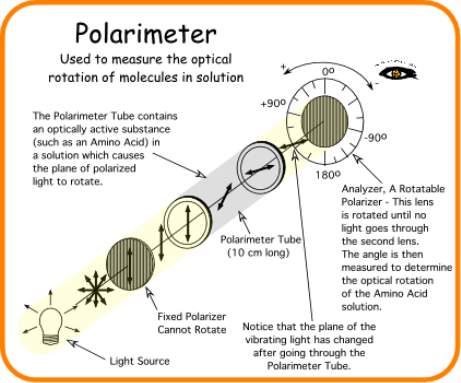
Fig 3.2 Polarimeter principle[14]
On the other hand, polarimeter uses only clarified juice; preparation is difficult and lengthy task because of usage of lead acetate as a reagent for clarifying the juice. Hence, this method is not suitable and due to the presence of contaminants, robustness is also affected. %Pol can be measured by the below formula
Pol in cane=Pol in juice×(100-(fibre%+5)÷100)
3.3. Combined °Brix %Pol measurement
3.3.1. High performance Liquid Chromatography
It is also called high-pressure liquid chromatography. Components in mixture can be recognized, separated and quantified using this method. The device performs a pumping action which generates a gradient of two unique solvents, one steel enforced column and also a detector for conducting absorbance measurements. It depends upon the pressurized pumps to pass the liquid solvent which contains the sample mixture in the column. The column is filled with solid adsorbent material. Each constituent in the sample interacts slightly differently with the adsorbent material. This causing a range of flow rates for variety of components and leading to the separation of the components as they flow out of the column. Major parts present in HPLC are sampler, pumps and detector. The sampler mixes the sample mixture into a stream and it passes through the column. The pumps are designed to provide desired flow and manage the constituents present in mobile phase right through the column. The detector produces a signal proportional to a number of constituents of sample emerging through the column. Some of the detector commonly used are UV/Vis, photo diode array (PDA) or based on mass spectrometry. This leads to a quantitative analysis of sample components. A latest microprocessor and user based software controls the HPLC instruments and this provides information analysis. Models of mechanical pumps in HPLC instrument generates a composition gradient in the mobile phase by mixing multiple solvents together in ratios changing with time.
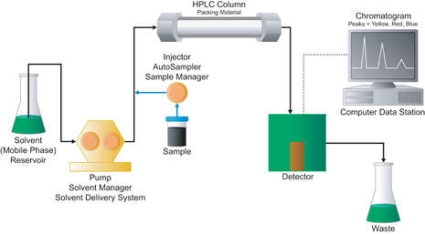
Fig 3.3. High-Pressure Liquid Chromatography [15]
Sugar content can be measured by the gas-liquid chromatographic (GLC) analysis. However, interfering compounds affects these methods. Hence, various sample pre-treatments are required. In addition to this, it is expensive and requires highly skilled personnel. Also, they consume time and hazardous chemicals should be properly handled in the laboratory.
3.3.2. NIR Spectroscopy
Chemical constituents can be determined successfully in a range of agricultural product using spectroscopy [16]. Measurements can be done both quantitatively and qualitatively using this method [3]. ].It is capable of measuring sugarcane quality.
It can be seen that NIR spectroscopy is capable of measuring the quality of sugarcane from both juice and non-juice (crushed) sample forms, whereas the other technologies are only capable of measuring juice samples [17]. This is a unusual feature of NIR spectroscopy due to its capability to calculate the variation of the light intensity either reflected or transmitted by both solid and liquid samples as a response to diverse chemical constituents of the samples. However, instead of their powerful performances and ability to be employed for different purposes, there is no published study addressing the application of this technology for measuring the quality of sugarcane in the field, either from sample forms of juice or non-juice. This is mainly because these spectroscopic technologies used in the laboratory are not suitable to be used in the field considering the potential damage created due to the harsh and dusty field environment. Careful handling of the equipment is required since it is heavy, fragile and expensive[18].
There is a source, a detector, and a dispersive component, (for example, a crystal, or, more typical diffraction grating) to allow the intensity at various wavelengths to be recorded. Fourier transform NIR instruments utilizing an interferometer are normal, particularly for wavelengths above ~1000 nm. Contingent upon the specimen, the range can be measured in either reflection or transmission. Normal brilliant or quartz incandescent lamp knobs are frequently utilized as broadband wellsprings of of NIR for analytical applications. LEDs are additionally utilized; they offer more noteworthy lifetime and spectral stability and diminished power requirements. For high exactness spectroscopy, wavelength-filtered lasers and frequency combs have as of late turned out to be capable sources, yet with in some cases longer acquisition timescales. At the point when lasers are utilized, a single detector with no dispersive components may be adequate. It can be reasoned that the normal innovations used to quantify sugarcane quality in labs; for example, refractometry, polarimetry, chromatography and laboratory NIR spectroscopy have extraordinary confinements in the field since they are regularly tedious, operator-dependent and require risky reagents[13]. The vast majority of these current advances additionally require juice tests for the quality estimation.

Fig 3.4 NIR Spectroscopy[19]
Be that as it may, getting adequate juice samples in the field is frequently exceptionally troublesome, particularly amid collecting. Another specialized test for juice estimation in the field is to prepare a raw juice into clarified juice. Hence, a non-juice sample form can be viewed as a superior option for field estimation. The main innovation that can be utilized to quantify sugarcane quality from a non-juice sample (macerated structures) is the NIR spectroscopic technique. Be that as it may, the planning of the sugarcane sample into a homogenous macerated shape for field measurement is still actually troublesome and can be a tedious undertaking. This sample form additionally requires appropriate equipment to macerate the sugarcane tests before the estimation. In this manner, the sugarcane test in a macerated shape still couldn’t be viewed as the best sample form for field utilize.
3.3.3. Biosensors
A biosensor is an analytical device, utilized for the location of an analyte that consolidates a biological component with a physicochemical detector. The sensitive organic component (e.g. tissue, microorganisms, organelles, cell receptors, proteins, antibodies, nucleic acids, and so forth.) is a naturally determined material or biomimetic part that cooperates (binds or perceives) with the analyte under review. The naturally delicate components can likewise be made by biological engineering. The transducer or the identifier component (works physicochemically; optical, piezoelectric, electrochemical, and so forth.) changes the signal resulting from because of the communication of the analyte with the biological component into another signal (i.e., transduces) that can be all the more effectively measured and evaluated. This occasionally represents the most costly part of the sensor gadget, be that as it may it is to generate an easy to understand display that incorporates transducer and sensitive component (holographic sensor). The readers are normally custom-designed and fabricated to suit the distinctive working standards of biosensors.
Another innovation used to quantify sugarcane quality is a biosensor. Biosensors are a dependable choice for assurance for sucrose as they are generally helpful, exact, and quick and cost is reasonable. A few biosensors have been produced to quantify sucrose in the sugarcane. In any case, the greater part of the traditional biosensors are physically intended for research center use and are not planned for handy use in the field.
A biosensor commonly comprises of a bio- recognition site, bio transducer segment, and electronic system which incorporate a signal amplifier, processor, and display. Transducers and electronics can be consolidated, e.g., in CMOS-based micro sensor systems. The recognition component, regularly called a bio receptor, utilizes biomolecules from creatures or receptors displayed after biological systems to associate with analyze of interest. This cooperation is measured by the bio transducer which yields a measurable signal relative to the presence of the target analyte in the example. The general point of the outline of a biosensor is to empower quick, convenient testing at the purpose of concern or care where the sample was acquired In a biosensor, the bio-receptor is designed to associate with the particular analyte important to create an impact quantifiable by the transducer. Generally, biosensors can be according to common types of bio-receptor associations including: anitbody/antigen, compounds/ligands, nucleic acids/DNA, cell structures/cells, or biomimetic materials.
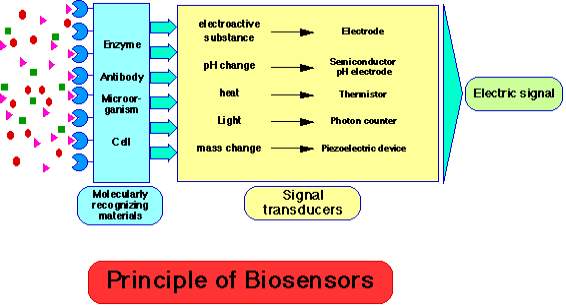
Fig 3.5 Principle of Biosensors[20]
The arrangement of the sensor is additionally complicated with a few little and delicate segments, for example, a buffer reservoir, pump and injector making this instrument deficiently robust for field utilize. The operation of the gadget additionally requires a significant level of expertise on the grounds that a reagent should have been blended with samples before measurement. For instance, active graphite paste blended with tetracyanoquinodimethane is required as a mediator for the sucrose measurement.
4. SUGARCANE QUALITY ESTIMATION USING NON DESTRUCTIVE TECHNIQUES
4.1. Electronic Refractometer
During the year 2002,An effort was taken to measure sugar content during harvest [21]. The authors developed a low-cost electronic refractometer together with a signal conditioning algorithm to quantify sugar content for determining optimum topping height the of a sugarcane stalk during harvesting The system worked well in a research facility, creating repeatable and exact outcomes for sucrose concentrations and was then placed over the topper of a reaper in the field. Significant field trials demonstrated constrained outcomes because insufficient juice sample was kept onto the sensor during harvesting, due to the presence of lots of junks and leaf materials, the effects of the review were poor which ruins freshly topped stalks. Subsequently, a system which can separate junk from samples and crush an adequate measure of juice is required before this device can be utilized as a part of the field. While demonstrating the review, it was found that during harvest, it was hard to acquire sufficient juice tests. Consequently, alternative sample form, potentially sugarcane stalk, which is generally simpler to quantify, ought to be examined [22].
Programmed Refractometer automatically measures the refractive index of an example. The measured refractive index of the sample depends on the critical angle of total reflection. A light source is engaged onto a prism by means of a lens system. A light source is can be a longer-life LED. An interference filter ensures the predetermined wavelength. Because of focusing light to a spot at the crystal surface, an extensive variety of various angles is secured. As appeared in the figure “Schematic setup of a programmed Refractometer” the measured sample is in direct contact with the measuring prism. The approaching of transmission of light beneath the critical angle of total reflection into the sample depends on the refractive in -dex of the prism. However, for higher angles of incidence, there is a complete reflection of light. This dependence of the reflected light intensity from the the incident angle is measured with a high-resolution sensor array. From the video signal brought with the CCD sensor the refractive index of the sample can be computed. Then angle of total reflection is found out.
However, this method is independent on the properties of sample. It is even conceivable to measure the refractive index of optically thick strongly absorbing samples or tests containing air pockets or strong particles. Moreover, just a couple micro liters are required and the example can be recovered. Here, vibrations and other ecological disturbances don’t affect the total reflection angle.
4.2. Microwave
Microwave brings on atoms that have two opposing poles and makes them turn. A good example is water molecules in magnetic field they’re subjected to. This is due to the fact that Microwave radiation provides an oscillating magnetic field. This can be done by constantly changing the orientation of the field. Those movements make polar particles like water begin spinning as they attempt to stay aware of the changing charges. As the molecules spin, they produce warm. This procedure is known as dipole rotation[23]. (“Dipole” essentially signifies “having two poles.”)
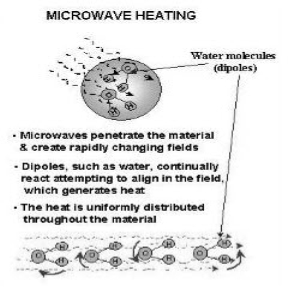
Fig 4.2 Microwave Heating
Few scientists examined that microwave engineering can be used to measure the dampness level and sugar content of sugarcane. In a microwave measuring instrument, the components of horticultural items are polarized at different qualities amid microwave transmission through the product bringing about the microwave signal losing speed and energy. This phenomenon causes a phase shift in the signal, and the weakening of the energy influences a weakening of the microwave.
This impact is increased disproportionately when the substance contains polar molecules like water.
The water impact on the signal is around 40-times more prominent than the impact of different parts, for example, sugar. Hence, since the microwave estimation is extremely sensitive to water, the relationship between’s water content and dry substance could permit an exceptionally exact estimation of the sugar content for sugarcane samples.
The utilization of the microwave sensor to measure the moisture content of forage has likewise been accounted in 1999 and revealed that microwave radiation can provide an exact and reliable measurement for crops like sugar beet and sugarcane. The dry substance of sugar syrup can likewise be measured online utilizing microwave innovation. Generally speaking, it creates the impression that in spite of the fact that this innovation has turned out to be progressively well known for lab use, there is no review with respect to the utilization of this technology for in-field moisture or sugar content estimation. Microwave innovation has the potential for use in the field, gave a reasonable juice extraction mechanism can be created.
4.3. Portable spectrometer
Another potential innovation for field uses is an ease and compact photodiodes array (PDA) spectrometer. To measure the quality parameters of maize and forage [24] amid collecting, PDA spectrometers can be mounted on combining the collectors. with silicon (Si) or Indium Galium Arsenide (InGaAs)detectors are outfitted in PDA Specrometers. The wavelength extend for Si indicator is from 350 to 1100 nm while for InGaAs indicator is in the vicinity of 400 and 1700 nm. Of these two indicators, the Si detector which is normally introduced in a portable VNIR spectrometer is picking up prominence for field utilize in light of the fact that it is minimal effort and sufficiently versatile for in-field estimations The VNIR spectrometer has been utilized to predict sugar content from solid samples such as apples.
The capacity to measure parameters from strong examples can permit fast and non-damaging estimation to be performed on in place organic product as complex sample preparation preceding the estimation is did not require anymore. In 2013, the hardware for measurement of soil dampness in the field was made online. In this way, considering the cost, portability , capacity to play out the estimation on intact samples and the capacity to be utilized for online measurement, this review has reasoned that a minimal effort and versatile VNIR spectrometer is a promising innovation for field utilize, in this way it merits researching as a best contender for field application.
4.4. Dielectric Based Non-Destructive Testing
4.4.1. Coaxial Probe
This coaxial probe method has the features of broadband, simple and convenient which is non-destructive, limited εr, accuracy and good for liquids or semi-solids. The coaxial probe is a cut off section of transmission line.
The material is measured by touching the probe to the flat face of a solid or immersing the probe into a liquid. At the probe end the fields are “fringe” into the material and change when come into contact with the material under test.
A typical measurement system using a coaxial probe method consists of a coaxial probe, network or impedance analyzer and software.
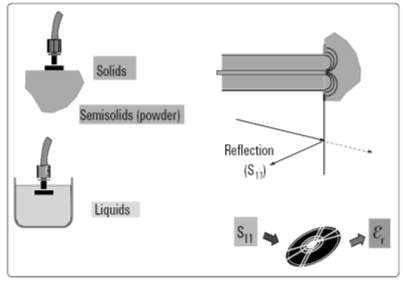
Fig 4.4.1 Coaxial Probe
Both the software and the probe are included in the 85070E dielectric probe kit. An external computer is needed to control the network analyzer through GPIB (General Purpose Interface Bus).. The 82357A USB to GPIB interface provides a flexible and convenient way to understand this connection. For the PNA family of network analyzers there is no need of any additional computer, hence the software can be installed directly in the analyzer.
For solid materials, an air gap in between the probe and sample could be a significant source of error. However this method has some main source of errors which are cable stability, air gaps and sample thickness. This method has the disadvantage of the dielectric probe method is the limited accuracy under certain conditions. So this method is not suitable for the measurement of sugarcane with good accuracy.
4.4.2. Transmission Lines
A conductor or conductors designed to carry electricity or an electrical signal over large distance with minimum losses and distortion. This method employs the material to be placed within an enclosed transmission line. Transmission line measurement system consists of a vector network analyzer, a coaxial airline or waveguide section, software such as the 85071E for conversion to εr and computer externally.
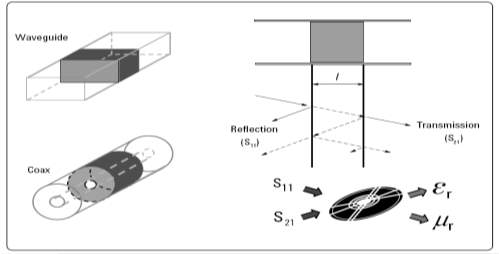
Fig 4.4.2 Transmission Lines
This type of coaxial transmission lines cover a broad frequency range, but toroid-shaped sample is difficult to manufacture. So transmission line method is not suitable for the measurement of sugarcane.
4.4.3. Free Space
Free space method has the features of non-contacting, non-destructive, high frequency which is low end limited by practical sample size, useful for high temperature measurements and measures magnetic materials. As this method is non-contacting it can be used in the measurement of materials at high temperatures and hostile environments.

Fig 4.4.3 Free Space method
The free space measurement setup consists of a vector network analyzer, a fixture (antennas, tunnels, arches, etc.,), software like the 85071 and computer. Accurate free space measurements are possible without expensive spot focusing antennas, micro positioning fixtures or direct receiver access. High temperature measurements are easy to perform by this method since the sample is never touched. This method is not suitable for the measurement of dielectric of the sugarcane because in free space the losses will be more.
4.4.4. Resonant Cavity
An enclosure which is able to maintain an oscillating electromagnetic field when suitably excited. The geometry of the cavity determines the resonant frequency. The broadband techniques employed in this method have low impedance, needs bigger samples to acquire good measurements and have the ability to measure at any given frequency. Resonant cavities are high Q structures and can resonate at certain frequencies. A piece of sample material affects the centre frequency and quality factor of the cavity.
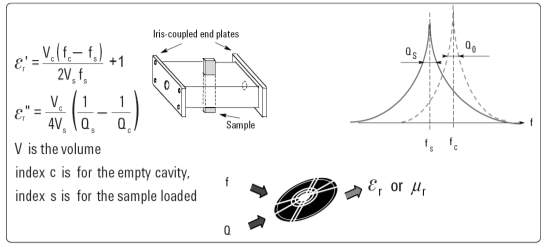
Fig 4.4.4 Resonant Cavity
The resonant cavity measurement system consists of a network analyzer, a cavity, software and computer. Although this method is accurate but it still has some errors. To measure small changes in the Q factor, the network analyzer should have excellent frequency resolution. The sample cross-section dimensions must be known previously. This method has limitation for low-loss samples due to low Q factor. The main disadvantage of this method is that this setup is difficult to manufacture.
4.4.5. Parallel Plate Capacitor
The parallel plate capacitor method includes placing a dielectric material between two electrodes to form a capacitor. This method has many features which include accuracy, convenience and material shape, reliable, cost efficient and easy to manufacture. We have the significant factors like frequency range, expected values of εr, measurement accuracy, material properties, form of material which includes liquid, powder, solid and sheet, sample size restrictions, non-destructive, contacting, temperature and cost. This method is quick compared other methods. This measurement method has many advantages over the other methods. So we prefer this parallel plate capacitor method for the measurement of capacitance and εr of the sugarcane samples.
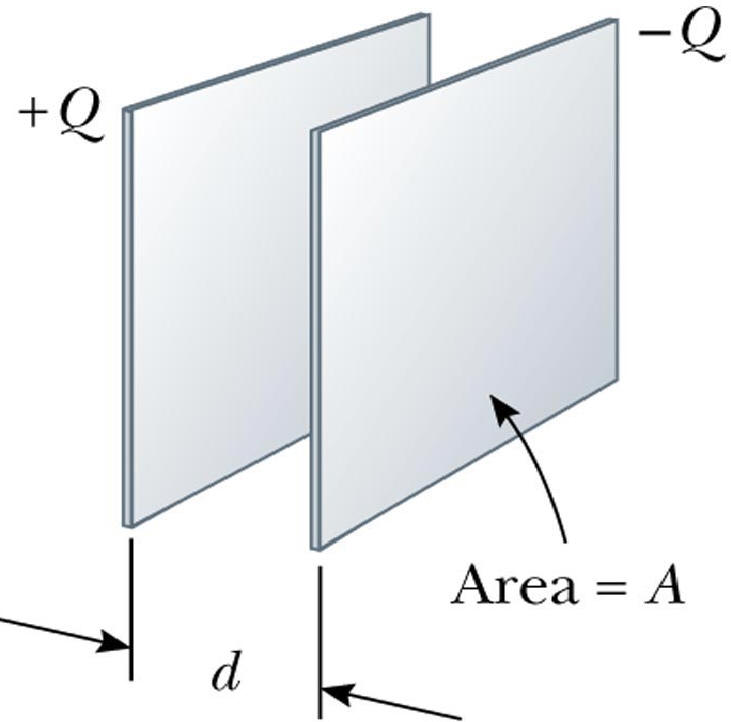
Fig 4.4.5 Parallel Plate Capacitor
5. POST-HARVEST QUALITY ESTIMATION BY CAPACITANCE BASED TECHNIQUE
5.1. Introduction
The conventional techniques employed to determine the quality of sugarcane are chemical based techniques. These techniques are time consuming and require a specialized laboratory to carry out the experiments. These chemical based techniques perform measurements on clarified sugarcane extracts. These sugarcane extracts are to be obtained manually and in turn require specialized tools for juice extraction. Therefore, these techniques cannot be employed for fast and in-field measurements. Thus non-destructive, quick and in-field measurements of sugarcane quality are needed to determine the amount of recoverable sugar available at the time of crushing. In chapter 4, the various means of non-destructive quality estimation techniques were discussed.
Based on various factors, the parallel plate capacitor method was selected for the quality measurement of sugarcane stalks. The capacitor was excited with various frequencies in the range of 1 kHz to 1 MHz The voltage used to excite the capacitance set-up is set at 5 V. A mixed domain oscilloscope was used to see the output voltages obtained from the impedance set-up. From the capacitive reactance XC, the value of capacitance was calculated and in turn the dielectric εr value of the capacitance medium was calculated.
The dielectric based method is very effective when it comes to the measurement of samples containing moisture content. When measuring sugarcane stalks, there is an added advantage of the dissolved sucrose, a major recoverable sugar which leads to increased values of relative permittivity. From a study conducted, it was observed that the dissolved sucrose content in sugarcane stalks reduces every 24 hours.
The major chemical reaction taking place is the conversion of sucrose into reducing sugars. Reducing sugars are not conductors of electricity by nature. The measure of total soluble solids is also a parameter for quality estimation[25]. The increasing amount of reducing sugars adds up to the total soluble solids in the sugarcane. It is seen from a research work that the values of total soluble solids increase with the increase in number of days. With the decrease in dissolved content of sucrose in water, the dielectric of sugarcane stalks decreases. This is clearly exhibited when the different concentrations of sucrose in water were tested to obtain the relative permittivity values[26]. Thus, it can be correlated that the amount of dissolved content of sucrose in sugarcane extract is directly proportional to the value of relative permittivity values obtained. This correlation explains why there is a decrease in relative permittivity values taken every day after harvest[26], [27].
There is a consistent increase in weight loss every 24 hours post-harvest. Thus, weight loss can also be taken as a quantitative parameter in estimating the quality of post-harvest sugarcane. The weight loss is expected to increase as a result of evaporation of moisture from the sugarcane samples[8]. Thus, the obtained relative permittivity values can be correlated with the increase in moisture or weight loss. As seen, evaporation takes place every day and thus weight loss is consistent. The weights of every sugarcane variety can be measured and logged in a database. The relative permittivity values taken every day can be correlated with the everyday weight values and thus the weight of a particular sample can be determined with the obtained relative permittivity value. This can in turn be used to estimate the age of the post-harvest sugarcane which in turn predicts the quality of sugarcane.
The conventional quality parameters of weight loss and Brix can be correlated with the obtained relative permittivity values. This correlation has to be done for every day after the sugarcane samples have been harvested. The obtained relative permittivity values can thus be used to estimate the weight loss and Brix value. These can be in turn used to estimate the quality of sugarcane samples.
A parallel plate based approach towards determining the dielectric values are simple in design, rapid in obtaining measurements, and reliable. These unique qualities make the estimation of dielectric using parallel plate capacitance a reliable parameter for correlation with conventional quality parameters.
5.2. Material and methods
5.2.1. Sugarcane Samples
Sugarcane samples were taken from the following four commercial varieties
- CO 95020
- CO 86032
- CO 86010
- CO 06022
These varieties were collected from different fields of the Sugarcane Breeding Institute, Coimbatore, India. 30 stalks from each variety were obtained and a total of 120 stalks were obtained. An internode sample of 70mm size was cut from the middle section of each sugarcane stalk. Thus, 120 internode samples were cut from 4 varieties of sugarcane. After cutting, the internodes were labeled and transported immediately to the laboratory to avoid post-harvest quality deterioration of sugarcane. The experiments were carried out in laboratory at room temperature of 25° C.
5.2.2. Measurement Setup and dielectric modeling for sugarcane
To measure the dielectric properties of sugarcane, two rectangular parallel plate capacitors with dimensions of 70 X 35 mm in length and width was taken. The largest diameter (D) of the sugarcane sample was measured using a digital vernier caliper. This diameter of sugarcane internode was taken to be the distance of separation between the plates. The metal plates of the parallel plate capacitor were made of aluminum sheets of 0.5mm thickness to reduce errors arising due to the ionization of metal plates [28]. The sugarcane was used as a dielectric medium and it was placed in between the parallel plate capacitor. The parallel plate capacitor was connected in series to a standard capacitor. The capacitance setup was connected to 0 -10 MHz Signal generator (Scientech4062) and excited using 5 Volt peak to peak sinusoidal waves at different frequency ranging between 0 – 1 MHz. The voltage Vo across the standard capacitor was measured at various frequencies using a Mixed Domain Oscilloscope MDO4024C (Tektronix, Inc). The relative permittivity of the dielectric medium was measured by calculating the capacitance of the parallel plate capacitor.
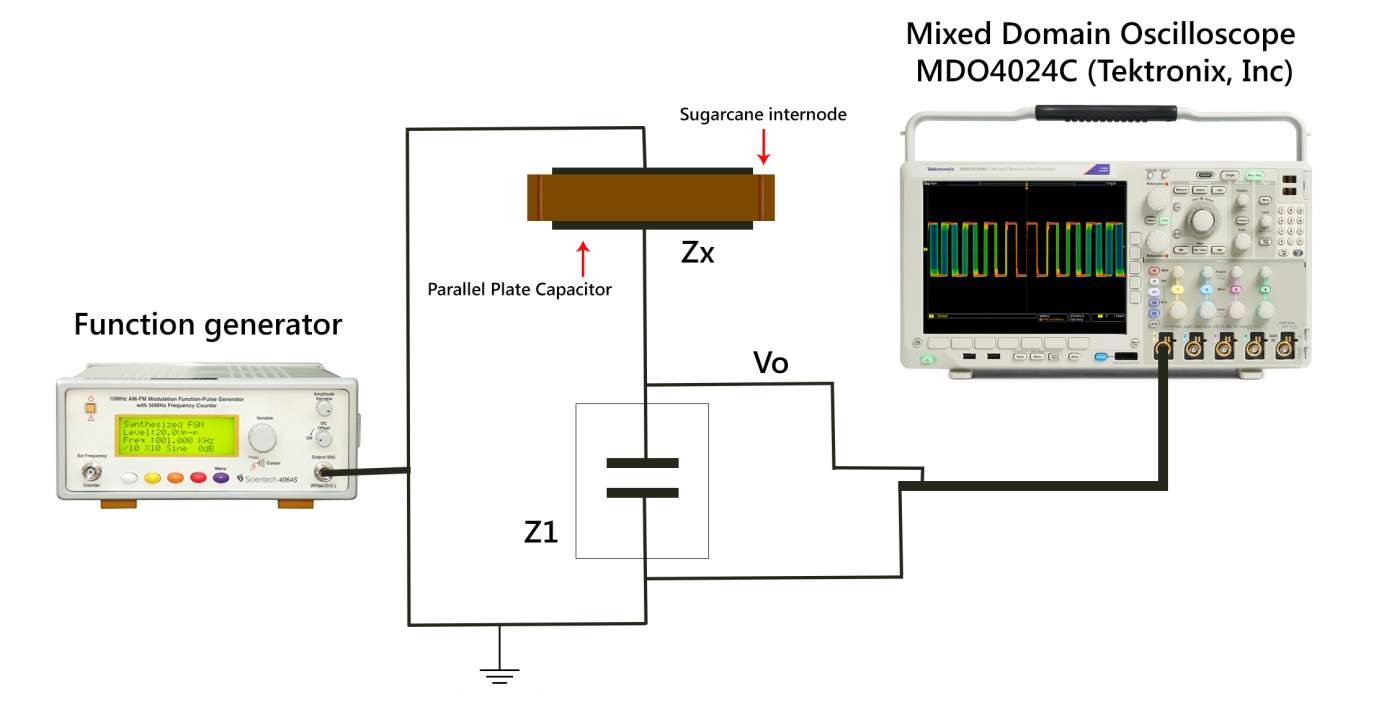
Fig (5.2.2) Measurement Set-Up for Post-harvest Quality Estimation
5.2.3. Mathematical Modeling
From the voltage divider circuit (Error! Reference source not found.) we can relate the voltage and impedance as:
| VoVi = ZXZX+Z1 | (1) |
where Vo is the measured output voltage, Vi is the input voltage (5Vp-p), Zx and Z1 are the impedance of parallel plate capacitor and standard capacitor which is a function of capacitance and applied frequency.
Substituting Zx =
1jωCx and Z1 =
1jωC1in (1)
| VoVi=1jωCx1jωCx+1jωC1 | (2) |
Simplifying equation (2), we obtain a relationship between Voltage and Capacitance as:
| VoVi=C1Cx+C1 | (3) |
| From equation (3), the value of
Cx is obtained. The dielectric value of sugarcane εr was calculated using the formula: |
|
| εr=Cx DεoA | (4) |
where ‘A’ is the area of the plates and εo is the Permittivity of free space (8.854 x 1012 F/m).
5.2.4. Laboratory Measurement of °Brix and weight loss
Sugarcane internode samples were crushed; cane juice was extracted from each sugarcane samples and filtered with muslin cloth. °Brix readings for the extracted juice were recorded every day using a Digital hand held Pocket Refractometer PAL- α (Atago Co., Ltd). A study by S. K. Uppal 2003 shows that the loss in sugarcane weight is primarily due to loss in moisture content of sugarcane[9]. Each internode samples were weighted using a digital weighing balance every day.
The loss in percentage weight of sugarcane was calculated using the formula
% Percentage loss in cane weight = Initial weight-Final weightInitial weight X 100
5.2.5. Statistical analysis
The values of relative permittivity, percentage weight loss and total soluble solids were obtained and analyzed using Microsoft Excel 2010. Regression was employed to obtain the coefficient of determination parameter R2. These R2 values were used to find the most suitable frequency/frequencies that could estimate the quality of sugarcane stalks reliably. Polynomial regression was employed to find the equation of the curve that best fits the relative permittivity vs. conventional quality parameters graph. The obtained equation can in turn be used to predict the quality of sugarcane stalks.
5.3. Results and discussions
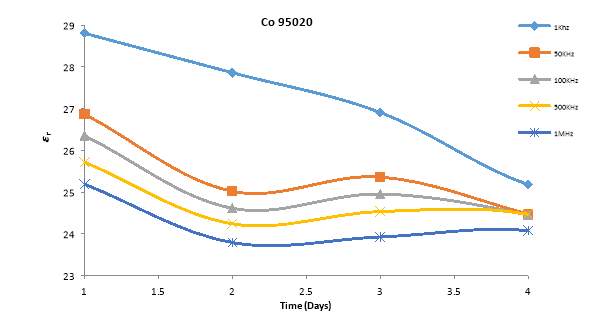
5.3.1 Variation of relative permittivity over time
Fig (5.3.1.a) Time (in Days) vs. Relative permittivity for CO 95020
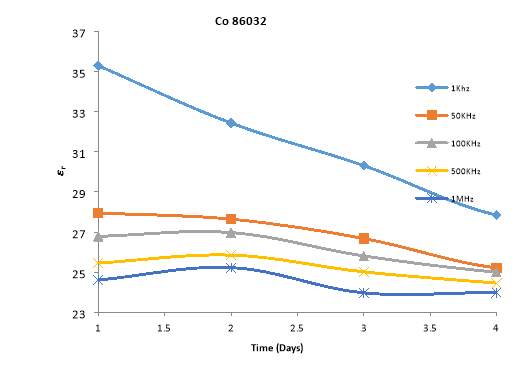
Fig (5.3.1.b) Time (in Days) vs. Relative permittivity for CO 86032
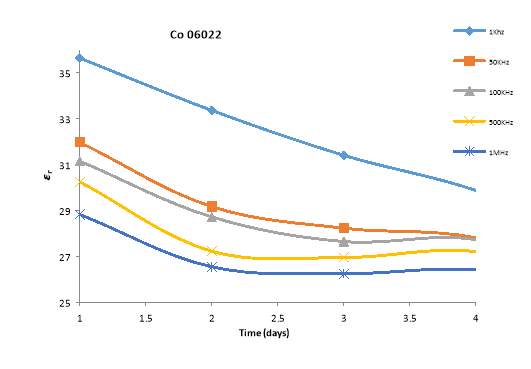
Fig (5.3.1.c) Time (in Days) vs. Relative permittivity for CO 06022
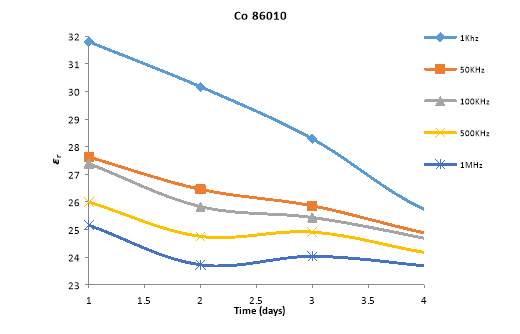
Fig (5.3.1.d) Time (in Days) vs. Relative permittivity for CO 86010
The graphs in Fig (5.3.1) show the mean relative permittivity of all sugarcane samples obtained at five frequencies for five consecutive days. Decrease in relative permittivity was seen over all four days after harvest when measured at five frequencies namely 1 kHz, 50 kHz, 100 kHz, 500 kHz and 1MHz. Fig 2.1 shows a consistent slope only for the 1 kHz curve in the variety Co 95020. In the variety Co 86032 (Fig (5.3.1.b)) and Co 06022 (Fig (5.3.1.c), the curves corresponding to 1 kHz and 50 kHz exhibit a consistent slope. The variety Co 86010 shows consistent slopes at three frequencies of 1 kHz, 50 kHz and 100 kHz. Similar variation of dielectric constant was seen in ripening period of banana [1].
Linear Regression was obtained for all the curves in the Figure 5.3.1 and the following results attained were tabulated in the Table 5.3.1.
| Variety | Frequency | R2 | Variety | Frequency | R2 |
| CO 95020 | 1 kHz | 0.9849 | CO 86010 | 1 kHz | 0.99 |
| 50 kHz | 0.8649 | 50 kHz | 0.9923 | ||
| 100 kHz | 0.8057 | 100 kHz | 0.94 | ||
| 500 kHz | 0.7104 | 500 kHz | 0.9023 | ||
| 1 MHz | 0.6325 | 1 MHz | 0.7195 | ||
| CO 86032 | 1 kHz | 0.9693 | CO 06022 | 1 kHz | 0.9959 |
| 50 kHz | 0.9437 | 50 kHz | 0.9242 | ||
| 100 kHz | 0.9143 | 100 kHz | 0.896 | ||
| 500 kHz | 0.8384 | 500 kHz | 0.7494 | ||
| 1 MHz | 0.59 | 1 MHz | 0.7551 |
Table 5.3.1 Linear Regression for the graphs in Fig (5.3.1)
The table 5.3.1 shows the coefficients of determination R2obtained through Linear Regression. The curves which exhibited R2values greater than 0.95 were selected and highlighted. The minimum value of 0.95 was selected so as to ensure high accuracy in determining the relative permittivity values as a function of days after harvest. The highlighted values indicate that the 1 kHz frequency is the most suitable in determining the relative permittivity values as a function of days.
5.3.2 Variation of Total Soluble Solids (˚Brix) over post-harvest days
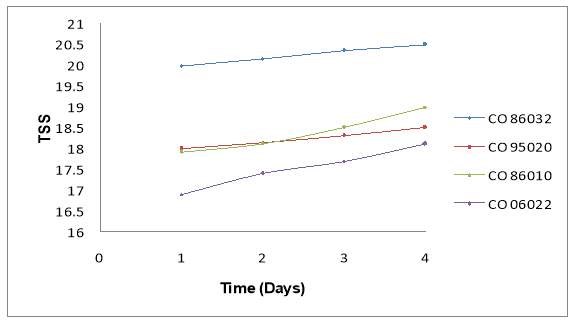
Fig (5.3.2) Variation of Total Soluble Solids (˚Brix) over post harvest days
The post-harvest observations for the values of Total Soluble Solids (TSS) for the four varieties are plotted in Fig. 3. The TSS values of all four varieties were found to increase steadily starting from the first day after harvest. This increase in ˚Brix values can be attributed to the formation of reducing sugars and dextran by the inversion action of sucrose [2].
5.3.3 Variation of dielectric permittivity with respect to Total Soluble Solids (˚Brix)
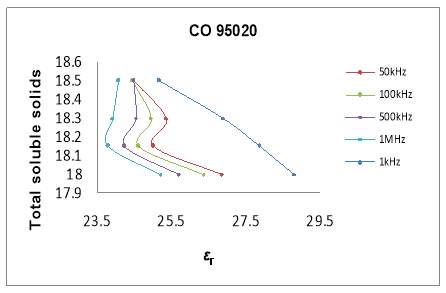
Fig (5.3.3.a) Variation of TSS with Relative permittivity values for CO 95020
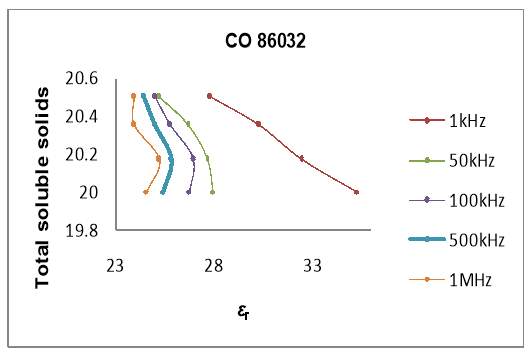
Fig (5.3.3.b) Variation of TSS with Relative permittivity values for CO 86032
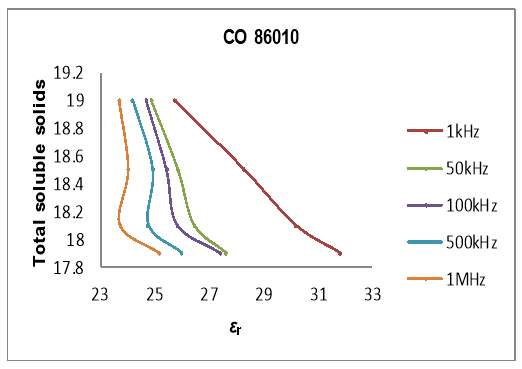
Fig (5.3.3.c) Variation of TSS with Relative permittivity values for CO 86010
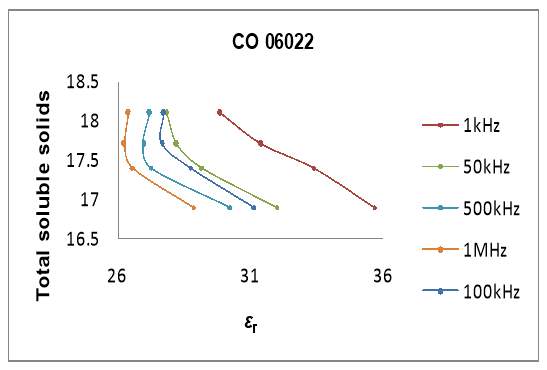
Fig (5.3.3.d) Variation of TSS with Relative permittivity values for CO 06022
The obtained values of total soluble solids as a function of the relative permittivity values are plotted in figure.4. The graphs are primarily seen for consistency in their slopes although consistency alone cannot be taken to be one of the major factors that determine the concluding frequency for system calibration. Consistent slopes are determined by observing the curves for linear decrease or increase in slopes. The following observations were made:
- In the variety CO 95020 (Fig. 5.3.3.a), the curve at 1 kHz is found to have a consistent slope whereas the other frequencies were inconsistent.
- In the variety CO 86010(Fig 5.3.3.b), the curves at 1 kHz, 50 kHz and 100 kHz are found to have consistent slopes.
- In the variety of CO 86032(Fig 5.3.3.c), the curves at 1 kHz and 50 kHz are found to have consistent slopes.
- In the variety of CO 06022(Fig 5.3.3.d), the curves at 1 kHz and 50 kHz are found to have consistent slopes.
| Variety | Frequency | R2 | Variety | Frequency | R2 | |||
| CO 95020 | 1 KHz | 0.993 | CO 86010 | 1 KHz | 0.992 | |||
| 50 KHz | 0.7287 | 50 KHz | 0.932 | |||||
| 100 KHz | 0.6127 | 100 KHz | 0.821 | |||||
| 500 KHz | 0.4105 | 500 KHz | 0.7086 | |||||
| 1MHz | 0.367 | 1MHz | 0.4374 | |||||
| CO 86032 | 1 KHz | 0.995 | CO 06022 | 1 KHz | 0.992 | |||
| 50 KHz | 0.9111 | 50 KHz | 0.9014 | |||||
| 100 KHz | 0.8365 | 100 KHz | 0.8433 | |||||
| 500 KHz | 0.6743 | 500 KHz | 0.673 | |||||
| 1MHz | 0.4667 | 1MHz | 0.7066 | |||||
Table 5.3.3: Polynomial regression done for all varieties for relative permittivity vs TSS.
In Table 5.3.3, it is observed that polynomial regression has been done for all varieties in the Fig (5.3.3) for all frequencies. From the Table 5.3.3, the following observations are made:
- In the variety CO 95020, high coefficient of determination value of R2 , 0.993 is observed for the frequency of 1 kHz. Whereas, the other frequencies exhibit lower coefficients of determination values of R2 lesser than 0.95.
- In the variety CO 86032, high coefficient of determination value of R2 ,0.995 is observed for the frequency of 1 kHz. Whereas, the other frequencies exhibit lower coefficients of determination values of R2 lesser than 0.95.
- In the variety CO 86010, high coefficient of determination value of R2 ,0.992is observed for the frequency of 1 kHz. Whereas, the other frequencies exhibit lower coefficients of determination values of R2 lesser than 0.95.
- In the variety CO 86010, high coefficient of determination value of R2 ,0.992is observed for the frequency of 1 kHz. Whereas, the other frequencies exhibit lower coefficients of determination values of R2 lesser than 0.95.
5.3.4 Variation of weight loss over time
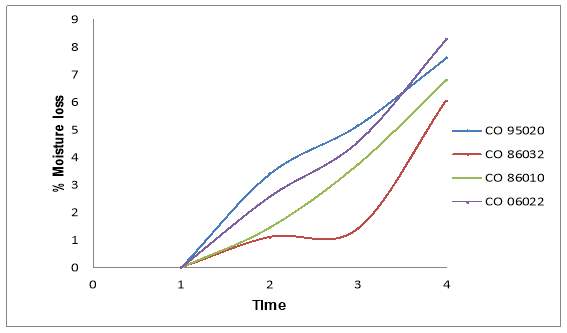
Fig (5.3.4) shows the variation of weight loss over time for all varieties.
5.3.5 Variation of dielectric permittivity with respect to percentage weight loss
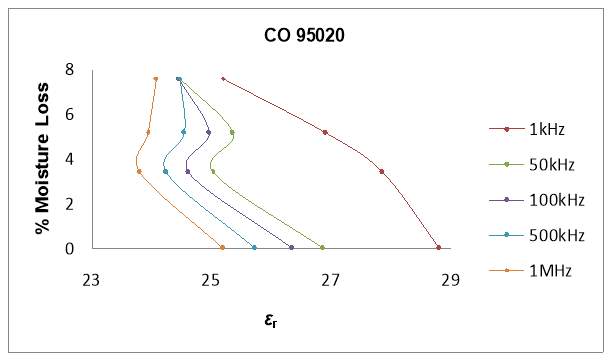
Fig (5.3.5.a) Variation of dielectric permittivity with respect to percentage weight loss for CO 95020

Fig (5.3.5.b) Variation of dielectric permittivity with respect to percentage weight loss for CO 86032

Fig (5.3.5.c) Variation of dielectric permittivity with respect to percentage weight loss for CO 86010
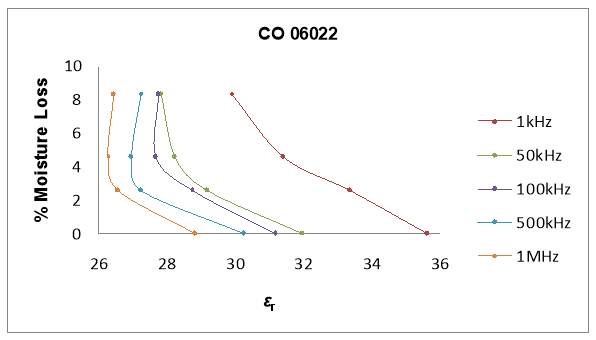
Fig (5.3.5.d) Variation of dielectric permittivity with respect to percentage weight loss for CO 06022
The % weight loss as a function of the relative permittivity values are plotted in figure 6. When compared with % weight loss, Fig. 5.3.5.a, 5.3.5.b, 5.3.5.c and 5.3.5.d shows that therelative permittivity of sugarcane was the highest, when measured at the lowest frequency1 KHz, and the lowest at the highest frequency 1 MHz in all varieties of sugarcane. Decreasing trend of % weight loss is seen with respect to relative permittivity of the sugarcane sample over time.
From Table 2, it is observed that the variety CO 95020 had high R2 value with 0.995 for 1 kHz. For CO 86032, the frequency curve at 1 kHz was found to have a consistent slope with high R2 value0.95.For CO 86010, the 1 kHz curve was found to have a R2 value of 0.9961. 1 kHz curve of CO 06022 was found to have a high R2 value of 0.9588.
| Variety | Frequency | R2 | Variety | Frequency | R2 |
| CO 95020 | 1 KHz | 0.995 | CO 86010 | 1 KHz | 0.9961 |
| 50 KHz | 0.8423 | 50 KHz | 0.940 | ||
| 100 KHz | 0.756 | 100 KHz | 0.842 | ||
| 500 KHz | 0.5734 | 500 KHz | 0.736 | ||
| 1MHz | 0.5309 | 1MHz | 0.467 | ||
| CO 86032 | 1 KHz | 0.95 | CO 06022 | 1 KHz | 0.9588 |
| 50 KHz | 0.914 | 50 KHz | 0.7934 | ||
| 100 KHz | 0.77 | 100 KHz | 0.7178 | ||
| 500 KHz | 0.69 | 500 KHz | 0.5281 | ||
| 1MHz | 0.2975 | 1MHz | 0.5632 |
Table 5.3.5 : R2 values for Relative permittivity values vs % Weight Loss
5.6 Validating best frequency for sugarcane quality prediction
The frequencies for which the R2 values in tables 5.3.1, 5.3.3 and 5.3.5are greater than 0.95 are tabulated in table 5.3.6:
| Variety | εr vs Time | εr vs TSS | εr vs Weight Loss | |||
| Frequency | R2 | Frequency | R2 | Frequency | R2 | |
| CO 95020 | 1 kHz | 0.9849 | 1 kHz | 0.993 | 1 kHz | 0.995 |
| CO 86032 | 1 kHz | 0.9693 | 1 kHz | 0.995 | 1 kHz | 0.95 |
| CO 86010 | 1 kHz | 0.99 | 1 kHz | 0.992 | 1 kHz | 0.996 |
| CO 06022 | 1 kHz | 0.9959 | 1 kHz | 0.992 | 1 kHz | 0.9588 |
Table 5.3.6 shows the frequencies for which the R2 values in all the above tables greater than 0.95.
The following observations are made from table 5.3.6:
- In variety CO 95020, the 1 kHz frequency can be used for dielectric based quality estimation as the R2 values in all the three tables 5.3.1, 5.3.3 and 5.3.6 are greater than 0.95.
- In variety CO 86032, the 1 kHz frequency can be used for dielectric based quality estimation as the R2 values in all the three tables 5.3.1, 5.3.3 and 5.3.6 are greater than 0.95.
- In variety CO 86010, the 1 kHz frequency can be used for dielectric based quality estimation as the R2 values in all the three tables 5.3.1, 5.3.3 and 5.3.6 are greater than 0.95.
- In variety CO 06022, the 1 kHz frequency can be used for dielectric based quality estimation as the R2 values in all the three tables 5.3.1, 5.3.3 and 5.3.6 are greater than 0.95.
Such high values of mean R2 obtained from table 5.3.6 reveals that the obtained relative permittivity values can effectively determine the amount of Total Soluble Solids and percentage weight loss at that time. These values can in turn be used to determine the quality of post-harvest sugarcane stalks.
A common similarity found in all the varieties that the frequency 1 kHz is found to be consistent by displaying high R2 values throughout. Thus it can be generalized that the 1 kHz frequency can be selected for the system calibration
6. CONCLUSIONS AND FUTURE SCOPE
This research aimed at designing a dielectric based system for determining the post-harvest quality of sugarcane stalks. Strong correlation was found between the obtained relative permittivity and the quality parameters Total Soluble Solids and percent weight loss.
From table 5.3.6, it was observed that the relative permittivity values can be correlated very well with the existing quality parameters such as total soluble solids and percentage weight loss. The obtained relative permittivity values when correlated with existing quality parameters showed high coefficient of determination values greater than 0.95. All varieties were consistent with the 1 kHz frequency as the R2values obtained in all three cases of Er vs time, TSS vs Er and Weight Loss vs Er are all consistently greater than 0.95.
The above observations reveal that each variety corresponds to one or more frequencies which could predict the quality of sugarcane stalks, when taken to calibrate the system. It is also understood that the 1 kHz frequency correlates very well with all the four sugarcane varieties and thus can be taken for system calibration in generalisation.
There is scope for making a low cost and portable device for the determination of sugarcane quality in the in-field conditions. Also, further research can be carried out to determine the relative permittivity of all sugarcane varieties for higher frequencies. A database can be created to log the values of relative permittivity for all sugarcane varieties taken with respect to the number of days after harvest.
REFERENCES
[1] R. Gupta, R. Kumar, and S. K. Tripathi, “Study on Agroclimatic Condition and Productivity Pattern of Sugarcane in India,” Sugar Tech, vol. 6, no. 3, pp. 141–149, 2004.
[2] N. M. Nawi, G. Chen, and T. Jensen, “In-field measurement and sampling technologies for monitoring quality in the sugarcane industry : a review,” 2014.
[3] N. M. Nawi, “DEVELOPMENT OF NEW MEASUREMENT METHODS TO DETERMINE SUGARCANE QUALITY FROM STALK SAMPLES,” 2014.
[4] A. K. Shrivastava, A. K. Srivastava, S. Solomon, A. Sawnani, and S. P. Shukla, “Sugarcane Cultivation and Sugar Industry in India: Historical Perspectives,” Sugar Tech, vol. 13, no. 4, pp. 266–274, 2011.
[5] “Sugarcane Internode.” [Online]. Available: source: http://www.sugarcanecrops.com/growth_morphology/stalk/. [Accessed: 26-Apr-2017].
[6] I. Singh and S. Solomon, “Post-harvest Quality Loss of Sugarcane Genotypes under Sub-tropical Climate : Deterioration of Whole Stalk and Billets,” Sugar Tech, vol. 5, no. 4, pp. 285–288, 2003.
[7] S. Solomon, “Post-Harvest Cane Deterioration and its Milling Consequences,” Sugar Tech, vol. 2, no. 1&2, pp. 1–18, 2000.
[8] S. K.Uppal, S. Bhatia, and K.S.Thind, “Pre milling cane preparation for high sugar recovery and reduction of post harvest losses in sugarcane,” Sugar Tech, vol. 10, no. 4, pp. 346–349, 2008.
[9] S. K. Uppal, “Post harvest losses in sugarcane,” Sugar Tech, vol. 5, no. 1, pp. 93–94, 2003.
[10] K. N. Reddy, Y. S., Madhuri, “Impact of delayed crush on post-harvest deterioration of promising early maturing sugarcane clones,” The Bioscan, vol. 9, no. 2, pp. 519–23, 2014.
[11] C. E. Benjamin, “SUGAR CANE YIELD MONITORING SYSTEM,” 2002.
[12] “Digital Refractometer.” [Online]. Available: https://www.agriculturesolutions.com/products/crop-soil-and-water-testing/refractometers-brix-meters/atago-pal-1-digital-brix-refractometer-0-53-brix-detail. [Accessed: 25-Apr-2017].
[13] N. Nazmi, K. Rowshon, C. Guangnan, and J. Troy, “Prediction of Sugarcane Quality Parameters Using Visible- shortwave Near Infrared Spectroradiometer,” Ital. Oral Surg., vol. 2, pp. 136–143, 2014.
[14] “Polarimeter.” [Online]. Available: https://en.wikipedia.org/wiki/Polarimeter. [Accessed: 23-Apr-2017].
[15] “High Pressure Liquid Chromatography.” [Online]. Available: www.waters.com/waters/nav.htm?cid=10049055. [Accessed: 05-Apr-2017].
[16] D. El Khaled, N. N. Castellano, J. A. Gázquez, and F. Manzano-agugliaro, “Dielectric Spectroscopy in Biomaterials : Agrophysics,” pp. 1–26, 2016.
[17] R. Mehrotra and H. W. Siesler, “Application of Mid Infrared/Near Infrared Spectroscopy in Sugar Industry,” Appl. Spectrosc. Rev., vol. 38, no. 3, pp. 307–354, Jan. 2003.
[18] H. Wang, J. Peng, C. Xie, Y. Bao, and Y. He, “Fruit Quality Evaluation Using Spectroscopy Technology :,” pp. 11889–11927, 2015.
[19] “NIR SPECTROSCOPY.” [Online]. Available: www.lla-instruments.com/process-analysis/analytical-methods.html. [Accessed: 26-Apr-2017].
[20] “Biosensors,” 2017. [Online]. Available: source: https://www.edgefx.in/biosensors-types-its-working-and-applications/. [Accessed: 26-Apr-2017].
[21] S. G. Mccarthy, “The Integration of Sensory Control for Sugar Cane Harvesters A Dissertation submitted by Doctor of Philosophy,” 2003.
[22] J. Taghinezhad, R. Alimardani, and A. Jafari, “Development of a Capacitive Sensing Device for Prediction of Water Content in Sugarcanes Stalks,” Int. J. Adv. Sci. Technol., vol. 44, pp. 61–68, 2012.
[23] S. O. Nelson, “Dielectric properties of agricultural products and some applications,” vol. 2008, no. 2, pp. 104–112, 2008.
[24] M. F. Digman and K. J. Shinners, “Real-Time Moisture Measurement on a Forage Harvester Using Near-Infrared Reflectance Spectroscopy,” vol. 51, no. 5. ASABE, St. Joseph, Mich., 2008.
[25] M. Soltani, R. Alimardani, and M. Omid, “Evaluating banana ripening status from measuring dielectric properties q,” J. Food Eng., vol. 105, no. 4, pp. 625–631, 2011.
[26] M. Naderi-boldaji and M. Fazeliyan-dehkordi, “Dielectric power spectroscopy as a potential technique for the non-destructive measurement of sugar concentration in sugarcane,” Biosyst. Eng., vol. 140, no. i, pp. 1–10, 2015.
[27] M. Soltani and F. Alimardani, “Moisture content prediction of Iranian wheat using dielectric technique,” J. Food Sci. Technol., 2012.
[28] M. Soltani, R. Alimardani, and M. Omid, “Prediction of banana quality during ripening stage using capacitance sensing system,” vol. 4, no. 6, pp. 443–447, 2010.
Cite This Work
To export a reference to this article please select a referencing stye below:
Related Services
View allRelated Content
All TagsContent relating to: "Agriculture"
Agriculture is the cultivating of food, goods or livestock through farming. Agriculture began independently at different times around the world thousands of years ago.
Related Articles
DMCA / Removal Request
If you are the original writer of this dissertation and no longer wish to have your work published on the UKDiss.com website then please:




